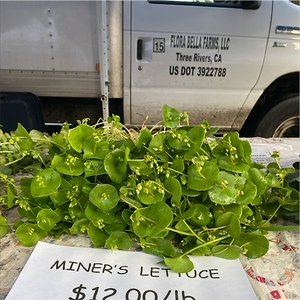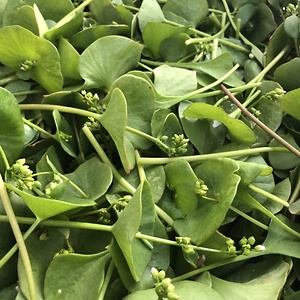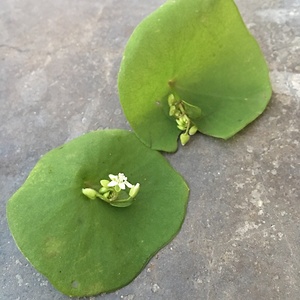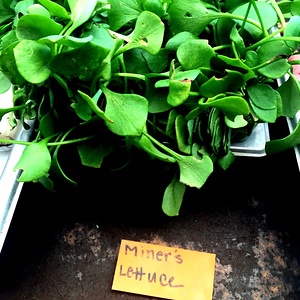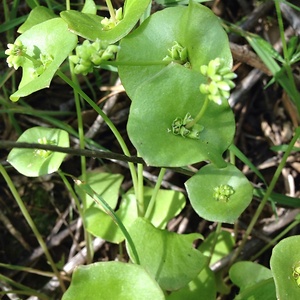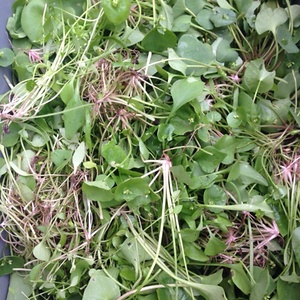


Miners Lettuce
Estimated Inventory, lb : 0
Description/Taste
Miner’s lettuce is small in size consisting of slender, trailing vines that have round, disk-like leaves. The tender, crisp leaves average 2-15 centimeters in diameter and grow in a rosette pattern, changing shape from lance, heart-shaped, to rounded as the plant matures. The leaves are also bright green and transition to deep red when they dry in warm weather. The central stem is pale green, smooth, and delicate, and in the spring, small pink or white flowers form in the center of the leaf. The vines are also slender and range 5-40 centimeters in height as they spread across the ground. Miner’s lettuce is crunchy, mild, and sweet, with a subtle earthiness.
Seasons/Availability
Miner's lettuce is available in the spring.
Current Facts
Miner’s lettuce, botanically classified as Claytonia perfoliata, is an annual trailing vine that is a member of the Montiaceae family. Also known as Winter Purslane, Indian lettuce, and Spring Beauty, Miner’s lettuce is found in the wild more than it is cultivated and grows prolifically in shady areas in coastal sage, fields, gardens, woodlands, and forests. Miner's lettuce is favored by foragers and home gardeners for its rapid growth, ability to be harvested multiple times throughout the season, and its crisp, sweet flavor to be used in both fresh and cooked applications.
Nutritional Value
Miner’s lettuce is an excellent source of vitamin C and vitamin A and also contains iron, beta-carotene, and protein.
Applications
Miner’s lettuce is best suited for both raw and cooked applications such as steaming, boiling, stir-frying or sautéing. Used similarly to spinach, Miner’s lettuce is most commonly used fresh in salads with other greens or displayed on appetizer plates as an edible garnish. It can also be cooked and served with meat dishes, paired with other spring vegetables, mixed into soups, or added to pesto. The flowers, leaves, and stems are all edible and can be cooked in delicate flavors as to not overpower the mild taste. Miner’s lettuce pairs well with chanterelle and morel mushrooms, wild ramps, grapefruit, blood oranges, kumquats, new potatoes, green garlic, scapes, spring herbs such as parsley, mint, and arugula, fresh hen and duck eggs, and cow's cheeses. The leaves will keep 3-4 days when stored in a sealed container with a damp paper towel in the crisper drawer of the refrigerator.
Ethnic/Cultural Info
Miner’s lettuce gets its name from the workers who traveled to California during the Gold Rush. Needing a source of vitamin C, gold miners quickly discovered from the Native Americans that Miner’s lettuce could be consumed both raw or cooked to prevent scurvy and other vitamin C related issues. Gold miners ate the plant in abundance as it was widely found growing wild in California. Today Miner’s lettuce is also a source of food for animals, providing a grazing source for gophers, flocking birds, quail, doves, and cattle.
Geography/History
Miner’s lettuce is native to the western coastal and mountain regions of North America and was spread to Europe in the late 1700s when it was brought back from an expedition to the new world. Today Miner’s lettuce is widely found in the wild and at specialty grocers in North America, Central America, Europe, and Australia.
Recipe Ideas
Recipes that include Miners Lettuce. One



